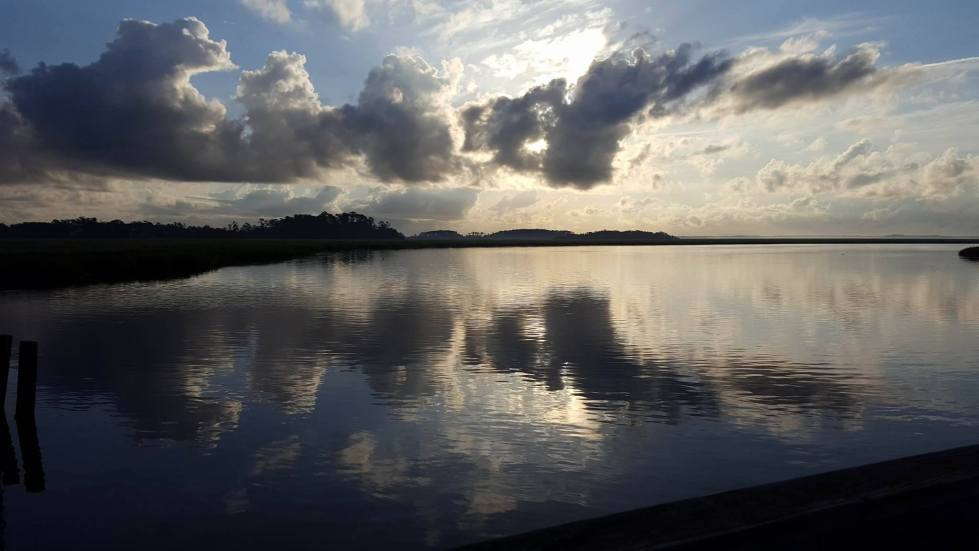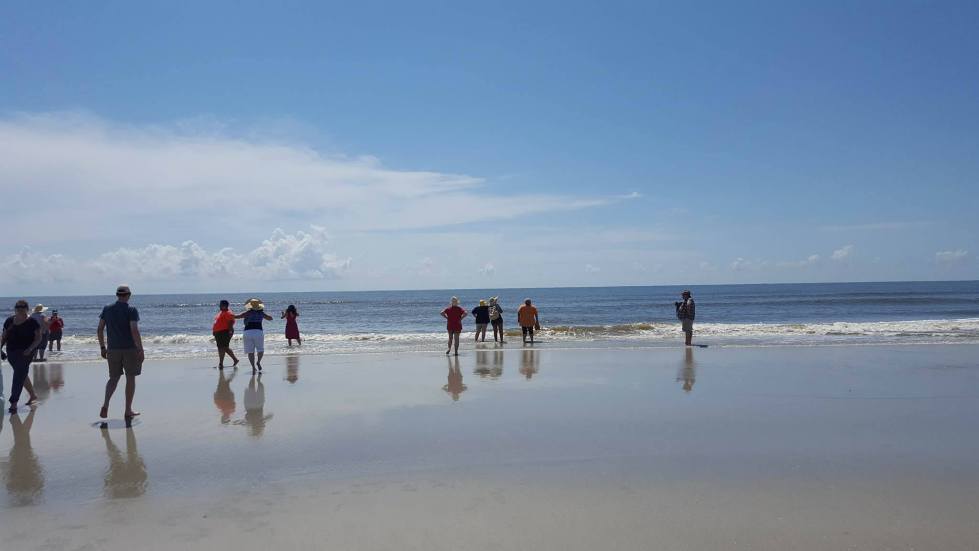Shall We Gather at the River?: Gullah Voices and Echoes

“My tale begins just before the rising of the sun…Dayclean, we call this, when the day is new and the world is made fresh again.”
—from God, Dr. Buzzard, and the Bolito Man by Cornelia Walker Bailey
Katie Underwood is ten years old. Named for the intrepid midwife who delivered countless babies in the Gullah Geechee communities that dotted Sapelo Island, Georgia for most of her 90 plus years, Katie Underwood, the ferry, is the newest public conduit across the river between Sapelo and Meridian, on the mainland, and a fitting namesake for a woman who devoted her life to ensuring safe water-borne passages.
It’s dawn, or dayclean in Gullah, as we await the ferry, or at least it was when our bus left Savannah at 6:15 AM, and we’ve come in search of “traditions and transformations.” Admittedly though, the only transformation that interests me this early in the morning is the one at the bottom of the extra cup of coffee which I neither have, nor would dare drink. Public restrooms on the island are scarce; we’ve been warned.
Meanwhile, I look around, or more accurately, I look down into and then across at the river, and suddenly understand Johnny Mercer’s compulsion to immortalize his love for these waterways in song. I’m referring of course to “Moon River,” the great American torch song to Mercer’s “huckleberry friend.” Unlike Mercer however, I lack both the music and the lyrics to do it justice, so pictures will have to suffice.
An hour later, the Katie Underwood delivers us safely to dry land, where we climb into a cheesebus that drops us onto the awaiting bosom of Sapelo Island.

The Gullah/ Geechee people of the Sea Islands along the shores of Georgia and South Carolina are remarkable for having retained so much more of the West African (specifically Sierra Leonean) culture of their ancestors, relative to other African Americans, due to their insularity and isolation from mainlanders. As one of a group of teachers taking part in a University of Connecticut/National Endowment for the Humanities summer seminar called Gullah Voices: Traditions and Transformations, I’ve spent nearly a week immersed in Gullah culture. And immersion, both literal and figurative, is the centerpiece of Gullah life. It began with the West African Bakongo worldview of the ancestors who believed that the ocean represented an equator of sorts, simultaneously connecting and separating the physical realm above ground from the spiritual/ancestral one below. This is a philosophy that lent itself easily to the rites of Christian baptism, and as exemplified by Geechee elder and cultural historian Cornelia Bailey’s account of her own baptism, this mini excursion to the spiritual world was taken very seriously in her community:
“If I was frightened, it was just a little bit. I didn’t let anybody know about it. The deacons said I was ready, so I had to be ready. I was saying to myself, ‘I don’t care if it kills me, I’m coming out of that water with a smile on my face.’ And I did. All they could say about me was, ‘That Cornelia was ready to be baptized, alright.’ ” (Bailey, 167)
Mrs. Bailey herself is the reason for our early morning pilgrimage to Sapelo. She is the penultimate Gullah cultural representative in a week that has been rich with them, including everyone from eminent historian, Dr. Emory Campbell to celebrated Gullah artist, Leroy Campbell. After stops at Behavior Cemetery, the Sapelo Island Post Office, the Reynolds (as in the infamous tobacco Reynoldses) Mansion, and at one of the most pristine beaches I’ve ever seen, it’s lunchtime, and our yellow school bus, illogically yet symbolically peopled by teachers, pulls into a clearing furnished with “haint” blue painted picnic tables that are practically draped in the overhanging moss from the live oaks that surround them.
Mrs. Bailey appears at about the same time as our homemade lunch of barbecued chicken, salad, green beans, and rice. Having spent 334 pages with her via her memoir, God, Dr. Buzzard, and the Bolito Man, I feel like I already know her. I envisioned her as a tall woman, and I can see from a distance that she is. But as she saunters in, greeting us in her contralto drawl, and sporting a floppy turquoise sun hat that is at once functional and flamboyant, I’m certain that I know her. In Cornelia Bailey, I recognize my mother, her mother, and my great-grandmother– all the female elders I grew up with who were or are (unknowingly) themselves griots: story-keepers and storytellers of our family and our culture’s lore.
During my time in the seminar, I’ve been struck not only by the richness and resilience of Gullah culture, but also by the fact that it’s endangered. Sapelo Island’s welcome sign lists a population of 70, but we’ve been told that the number is now closer to 40. What young people there are, eventually ride the Katie Underwood, or its equivalent out to greener pastures, leaving the older folks and much of their heritage behind.
Perhaps because of this, near the end of our time with her, I feel compelled to ask Mrs. Bailey who Sapelo’s next griot will be, and she readily offers some possibilities among her children. But somehow this perfectly satisfactory response leaves me unsettled, and I suspect it’s because the question and its answer hits too close to home, giving voice to my fear that when the time comes for my own family, if that mantle should fall on me, I may not be ready to be baptized.

_______________________________________________________________
More images from my “Gullah Voices” experience appear below. As always, please feel free to comment and/or share.









Line, this is marvelous. Thank you so much.
Thank you so much for reading, Monica. That was an experience that was hard to boil down into a few hundred words, but I decided to try after all.
Beautiful captures!
Thanks, Roselinde:)
Pingback: My Gullah Week | educating alice
Beautiful. Well done Line!